Authors: T M Wolf, B C Caldwell and J L Pederson. Originally published in Aspects of Applied Biology 71, 2004, in expanded form.
Abstract
Spray drift deposition into water bodies may pose environmental and health hazards, and buffer zones have been suggested as a means of mitigating water contamination. Field trials were conducted to determine the effect of nozzle type and riparian vegetation on spray drift deposition into wetlands. Three riparian vegetative types, minimal vegetation (grass), low vegetation (willow shrubs), and high vegetation (aspen trees) were compared with open field conditions. Spray was released upwind of wetlands with these riparian characteristics with conventional and air-induced low-drift nozzles. Low-drift nozzles reduced drift deposits by about 75% in the absence of any vegetation, and by 88 to 99% when vegetation was present. Dense willow shrubs resulted in anomalous downwind deposits, possibly because of air turbulence caused by low porosity characteristics. By considering vegetation effects, a 15-m buffer zone could be reduced to 5 to 7 m for conventional, and 1 to 4 m for low-drift nozzles without increasing deposits at the edge of the sensitive habitat. Both variables should be considered by regulatory bodies in their risk assessment procedures.
Introduction
Airborne transport is an important vector for movement of pesticides from agricultural land to receiving waters. In an effort to maintain low pesticide levels in water bodies in accordance with risk assessment protocols, the Pest Management Regulatory Agency (PMRA) is mandating minimum setback distances (buffer zones) from water bodies during a spray operation. Several additional variables can complement buffer zones in preventing spray drift, including low-drift sprays and riparian vegetation. Germany and the United Kingdom already account for these characteristics in their buffer zone regulations (Kappel and Taylor, 2002).
Vegetation has been shown to be effective at mitigating droplet spray drift in several recent studies and reviews (Richardson et al., 2002, Hewitt, 2001, Ucar and Hall, 2001) by reducing wind velocities and intercepting spray. The documented magnitude of the spray drift deposit reduction in these studies ranges from 50 to >95%, dependent on variables that include vegetation height, porosity and orientation relative to wind direction, and wind speed.
We studied the integrated effect of buffer zones, vegetative barriers, and low-drift sprays to determine the overall impact of spray drift deposition onto downwind water bodies.
Materials and Methods
Overview and Site Description
The study was conducted in 2001 on a farm field near Aberdeen, SK. Sprays were applied upwind of a water body, and drift deposits were collected on petri-plates placed near ground level. Experimental sites were chosen to represent different vegetation heights and types around the water body in question: low (uncut grass), intermediate (willow shrubs), and tall (aspen trees). These were compared to nearby open-field conditions. Two sprayer nozzle types were used in the study: conventional flat fan nozzles and venturi-type low-drift nozzles.
The grass barrier was comprised of a mix of grasses dominated by bromegrass (Bromus spp.) growing to a height of 75 cm. Willows (Salix spp.) were approximately 3 m tall with a density of about 0.15 m-2 and presented a fully foliated barrier for their full height. Willows extended for a width of about 7 m toward the edge of the water body. Trembling aspen (Populus tremuloides Michx.) were approximately 8 m tall, with foliation beginning 1.5 m above ground. Trees were present at a density of about 0.25 m-2 and extended for 8 m toward the water edge.
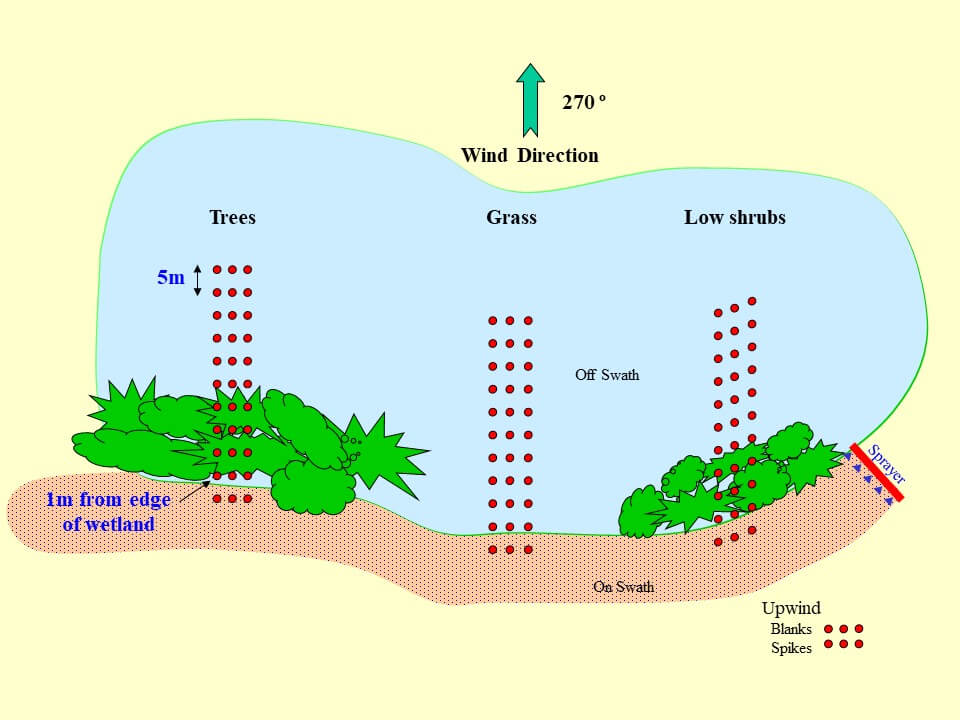
Spray Equipment and Application Method
A Melroe Spra-Coupe 220 was used to make the applications. This sprayer was equipped with conventional flat fan nozzles (XR8003) and air-induced low-drift nozzles (TD11003) at 275 kPa, producing ASABE Fine and Coarse sprays, respectively. The spray boom was 10 m wide and nozzles were 75 cm above ground. Sprayer travel speed was 12.9 km h-1, at which the application volume was 100 L ha-1.
The sprayer tank contained a mixture of 2,4-D amine4 (4 g L-1) and Rhodamine WT5 (2 mL L-1), a fluorescent tracer dye which would be used to quantify the deposits. 2,4‑D acted to photostabilize the dye, and also provided a spray formulation with physico-chemical properties representative of agricultural pesticides.
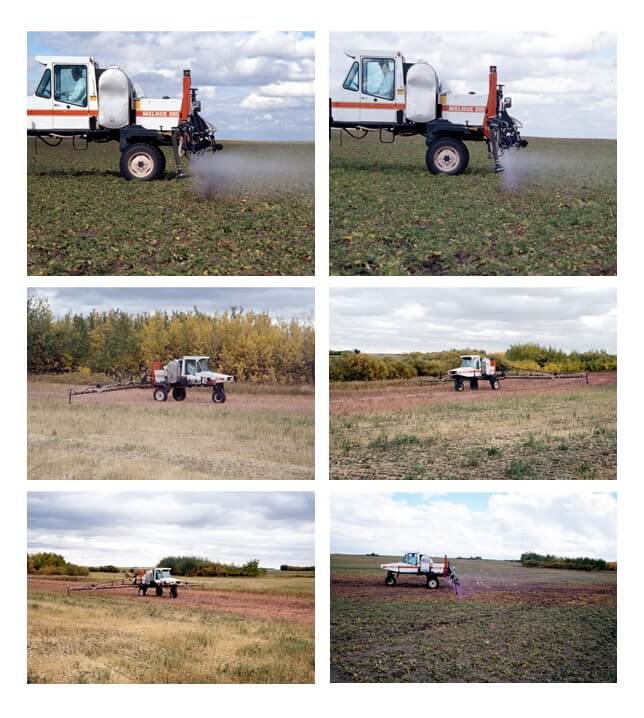
Middle row: Tall and medium vegetation
Bottom row: Short vegetation and open field
Application was made in a direction approximately perpendicular to the prevailing wind, with the downwind edge of the spray boom at the edge of the wetland’s riparian vegetation. This was usually about 15 m upwind of the edge of the water body (due to severe drought conditions, the wetland did not contain any water at the time of the trials). Three consecutive passes were made along the same swath in a 10-min period to obtain average meteorological conditions for all three vegetation types. Wind speed and direction, temperature and relative humidity were monitored during application using a portable micrometeorological station.
Sampler Layout
Downwind of the spray swath there were 3 parallel lines of eleven 15-cm diameter glass petri-plate samplers starting underneath the sprayer boom and extending 46 m downwind from the edge of the spray swath (Figure 1). Samplers were separated by 5 m within the line, and lines were about 2 m apart.
The deposition profile was also assessed under open field conditions, using the same sampler layout but on crop land with no riparian vegetation. These are referred to as ‘bare soil, or ‘reference’ samplers in this report and served as a baseline to determine the impact of the riparian vegetation.
Sample Collection and Analysis
Sample collection began 5 minutes after spray application was complete (See Table 2 for trial times). Beginning with the furthest downwind locations, petri-plates were covered with a plastic lid, and placed into dark boxes. Spray deposits on the samplers were washed off in the laboratory using 95% ethanol in three 15-mL washes. Final samples were made up to 50 mL. and two 20-mL sub-samples were collected in borosilicate vials and stored in the dark.
Within 24 h, subsamples were analyzed using a fluorescence spectrophotometer with excitation and emission wavelengths of 545 and 570 nm, respectively (Shimadzu Model RF-1501 spectrofluorometer equipped with Model ASC-5 auto-sampler). Instrument readings were converted to µg L-1 using standard curves and expressed as a percent of the applied dosage under the field sprayer.
The fluorescence spectrophotometer data were averaged over the three replicate sampling lines, adjusted for photolysis, and expressed as a percentage of the amount applied on-swath. Relationships of spray drift deposits with downwind distance were first visualized by plotting all data points, and then mathematically related through appropriate regression techniques.
Results
Meteorological Conditions
Weather conditions were favourable during the trials. Wind speed and direction were appropriate for the sampler layout and the experimental objectives. Mean wind direction varied by up to 44º from the ideal (270º) in 6 out of 12 trials, and was within 30º for the remaining 6 trials (Table 1). Mean wind velocities were consistently between about 17 and 21 km h-1 in all but one trial. Air temperature and relative humidity fluctuated between 14 to 22º C and 31 to 80%, respectively, on the trial dates.
Deposition Profiles
A visual review of the raw data suggested that a linear regression of the log of deposit amount and log of downwind distance would be appropriate. It was noted that for willow, the deposit profile tailed upwards after the 26 m mark. Based on a survey of the site, it was concluded that this tail was probably caused by the length of the spray pass exceeding the length of protection offered by vegetation. In other words, beyond the 26 m sample, drift had not been attenuated by a vegetative barrier. It is also possible that the airflow was deflected up over the low, non-porous barrier and returned to ground level beyond the 26 m distance (Carter et al., 2001).
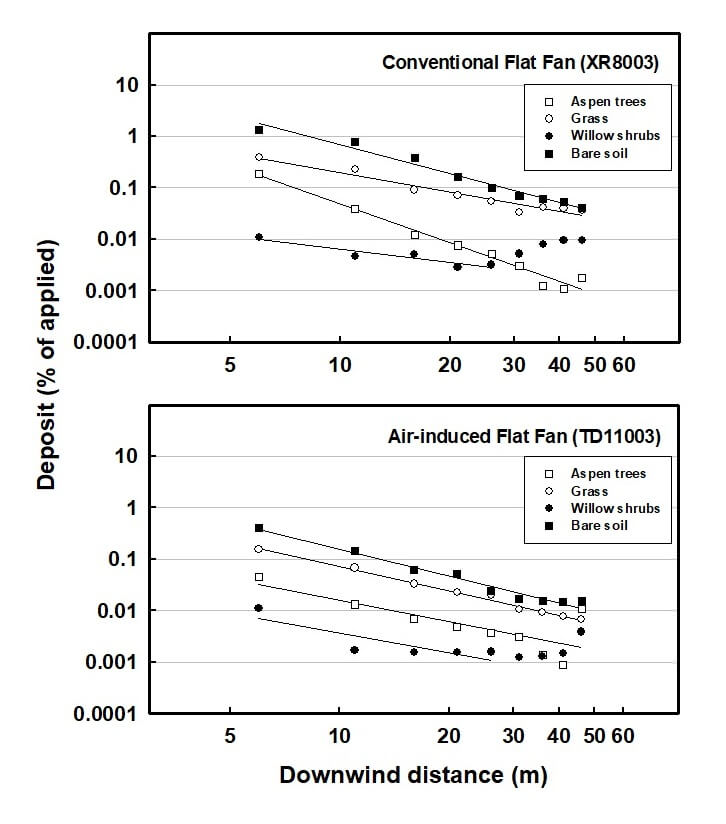
The deposition data for the willow were regressed from 6 to 26 m, all others were taken to 46 m (see text for explanation).
As a result of the questionable data for this vegetation type, it was decided that it would be misleading to include the furthest downwind data points. Implications of this observation will be discussed later in the manuscript. All regressions were statistically significant, explaining between 61 and 99% of the observed variation. In 5 of 8 trials, more than 90% of variation was explained.
Drift Mitigation by Riparian Vegetation and Application Method
The predicted drift deposit at 15 m was calculated for all trials based on the regression parameters (Table 3). For the conventional sprayer on bare soil, the deposit amount was 0.322% of the applied dose. The distance at which this specific deposit amount would be achieved was then calculated for all other trials. This value is the buffer zone distance at which equivalent protection to the reference system was offered. Buffer zones could therefore be reduced by 55% (grass), 99% (willow) and 69% (aspen) using the conventional nozzle and 56% (bare soil), 74% (grass), 98% (willow) and 92% (aspen) for the low-drift nozzle.
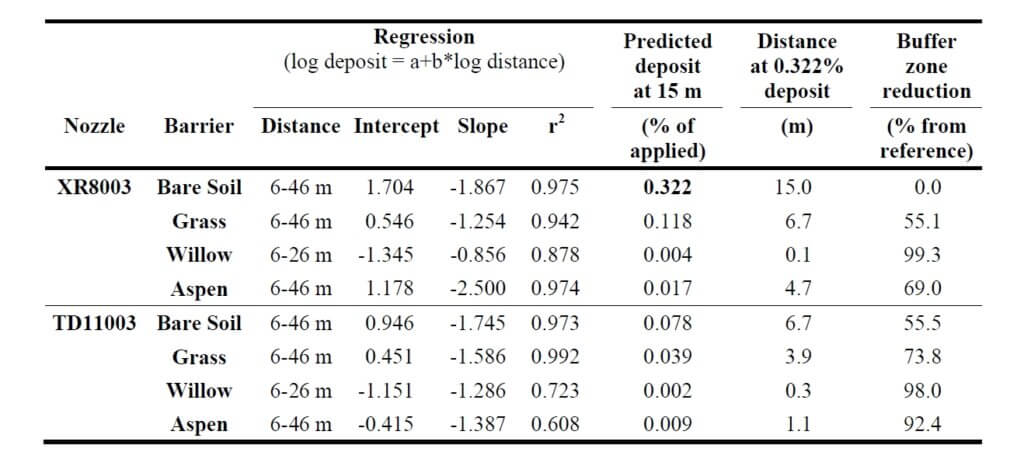
The calculated buffer zone reductions were not equivalent to the observed drift reductions due to the unique regression slopes of each deposition line. For example, expected drift deposits at 15 m downwind on bare soil were reduced by 77% when the air-induced low-drift nozzles were used (Table 4), whereas buffer zone distances could only be reduced by 56% (Table 3). Furthermore, the effectiveness of the grass vegetation diminished with distance, reducing drift by 64, 50, and 28% at distances of 15, 25, and 45 m, respectively. Therefore, a complete deposition profile will be required for each vegetation scenario to accurately adjust buffer zones.
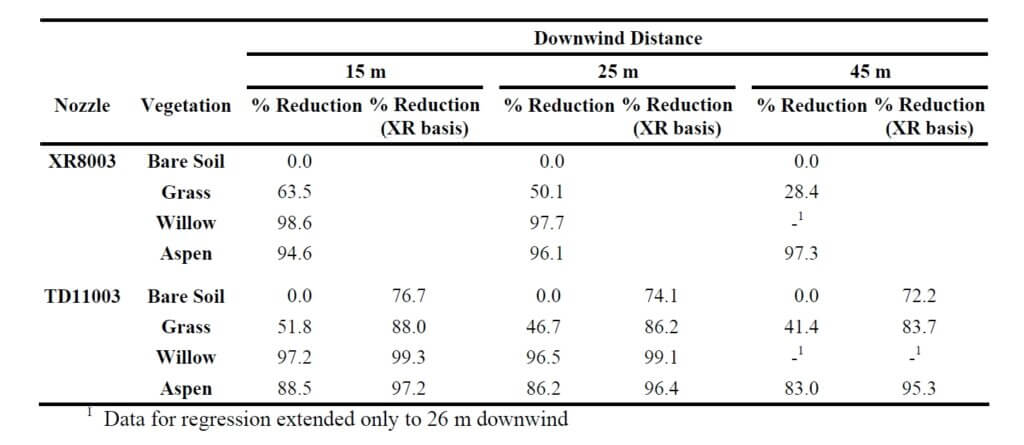
Riparian vegetation was typically more effective than low-drift nozzles in protecting water bodies from drift deposition. While grass reduced deposition by 28 to 64% from the conventional nozzle (depending on the downwind distance), willow and aspen reduced deposition by between 95 and 99% (Table 4). The willow was not considered at further distances since the data used for the regression were truncated at 26 m. Low-drift sprays provided some additional protection in all cases except for trees at the 45 m distance, where deposits increased slightly relative to the conventional spray.
Discussion
The aerodynamics of vegetative barriers are a complex phenomenon. Wind, upon reaching a solid barrier, is diverted up and over giving strongly turbulent conditions on the leeward side and a rapid return to free wind speed. For a permeable barrier like a hedge, the return to free wind speed is more gradual since some air filters through, reducing the pressure differential and allowing for less turbulence (Davis et al., 1994). Wind speed reduction is most pronounced for a distance of 5 H upwind and 30 H downwind at the 1 H height, where H is the height of the barrier (Rider, 1951). Nonetheless, there may still be an upward diversion of air (and spray drift) which may simply delay, not eliminate, sedimentation (Hewitt, 2001, Ucar and Hall, 2001), particularly for dense hedges (Carter et al., 2001). Richardson et al. (2002) did not, however, notice such a deflection up to 10 m height.
The reduction in drift deposition by riparian vegetation in this study is clearly significant, but is subject to some interpretation. These data were generated at a single site, and while this site was carefully selected to be representative and trials were repeated three times, it does not necessarily constitute an average result. There are clearly any number of possible arrangements of trees, shrubs and grass, plus any additional vegetative or landscape features which would influence drift deposition behaviour. However, due to the consistent nature of the data of this study, some confidence is attained in that the numbers are at least reliable for the given set of conditions. In this study, three spray passes were made along the same swath at the edge of the water body. Results could have been different had adjacent spray swaths been used, owing to the possible change in contribution of upwind swaths with the altered airflows under vegetated conditions.
Since the water body was dry, additional grass vegetation which had grown up could have made an effective collector of spray drift, possibly reducing deposit values beyond those that would have occurred in a water body. It is recommended that efforts be made to repeat these studies when water is present at normal values.
The mitigating effect of vegetation depends on the aerodynamic features of the vegetation, as well as the collection efficiency of their leaves, twigs, etc. This poses some difficulties because there are no absolute measures of these features. Permeability, for example, varies with wind speed owing to the movement of leaves, and winds speed itself varies with height (Davis et al., 1994). Collection efficiency of the vegetation varies similarly with target size, its movement, wind speed, and droplet size spectrum (Hewitt, 2001). However, there are opportunities for improved characterization with specialized equipment, such as that used by Richardson et al. (2002). Their LIDAR instrument was able to help calculate tree height and width, mean area index and mean area density. Work to further characterize vegetation will prove useful in future efforts to understand its mitigating potential.
Low vegetation such as grass has not received the recent attention of hedges and trees but has also been documented to reduce spray drift significantly. A study by Miller et al. (2000) documented significant reductions in airborne drift concentrations above uncut grass canopies, even at low plant densities. Bache (1980) documented similar reductions in spray drift when sprays were applied over a mature wheat crop compared to bare soil. Therefore the filtering effects of “low” canopies may be very significant and should be the subject of further study.
Riparian areas are regions of high biological activity and diversity, not only protecting adjacent water from outside influence, but also providing food and shelter for many species of wildlife. These areas must themselves be protected from harmful effects, which can include pesticides. Their efficient capture of sprays suggests some risk from pesticides capable of controlling perennial vegetation. Likewise, pesticide residues in this vegetation have the potential to be ingested by wildlife or be washed off with precipitation, resulting in movement into the water body. These effects must be considered when using vegetation to mitigate airborne drift.
Conclusions and Recommendations
- Vegetative barriers reduced spray drift deposition from conventional or low-drift nozzles into water bodies by 24 to 99%.
- Low-drift sprays reduced deposition by about 75%.
- Of the vegetation types, shrubs and trees had similar effects, reducing deposition from open-field conditions by an average of more than 95%. Low-drift sprays improved on this reduction.
- Calculated buffer zone reductions were less than drift deposit reductions. Accurate determination of buffer zone distances requires that the entire deposition profile be characterized.
- It is suggested that both riparian vegetation and sprayer technologies are important components of water body protection. Both should be considered in BMP and regulation development whenever the impact of pesticide applications near water bodies is to be estimated or mitigated.
Acknowledgements
The technical assistance of Glenda Howarth, Jill Clark, Rachel Buhler, Murray Nelson, Trevor Linford, and Pam Reynolds is greatly appreciated. Financial assistance was provided by the Rural Quality Program of the Agri-Food Innovation Fund, administered by the PFRA. The authors wish to thank Darrell Corkal and Clint Hilliard of PFRA for their enthusiasm, support and guidance directed towards this project, and Raymond Malko for making his land available for the trials.
Citations
Bache, D. H. 1980. Transport and capture processes within plant canopies. Spraying Systems for the 1980’s. BCPC Monograph No. 24, 127-132.
Carter, M. H., R. B. Brown, K. A. Bennett, M. Leunissen, V. S. Kallidumbil, and G. R. Stephenson. 2000. Methods for reducing buffer zone requirements for pesticide spraying adjacent to wetland environments. Sainte-Anne-de-Bellevue, Quebec: Proc. 2000 National Meeting, Expert Committee on Weeds / Comité d’experts en malherbologie [on-line: http://www.cwss-scm.ca/pdf/ECW2000Proceedings.pdf].
Davis, B. N. K, M. J. Brown, A. J. Frost, T. J. Yates, and R. A. Plant. 1994. The effects of hedges on spray deposition and on the biological impact of pesticide spray drift. Ecotoxicology and Environmental Safety 27:281-293.
Hewitt, A. J. 2001. Drift Filtration by natural and artificial collectors: a literature review. Special publication by Spray Drift Task Force, 12 pp. [on-line: http://www.agdrift.com]
Kappel, D. and W. A. Taylor. 2002. Buffer zones and “low drift” equipment. Hardi International Discussuion Paper, available from Hardi International A/S Helgeshøj Allé 38 DK-2630 Taastrup.
Miller, P. C. H, A. G. Lane, P. J. Walklate, and G. M. Richardson. 2000. The effect of plant structure on the drift of pesticides at field boundaries. Aspects of Applied Biology 57:75-82.
Richardson, G. M., P. J. Walklate, and D. E. Baker. 2002. Drift reduction characteristics of windbreaks. Aspects of Applied Biology 66:201-208.
Rider, N. E. 1951. The effect of a hedge on the flow of air. Quarterly Journal of the Royal Meteorological Society 78:97-101.
Ucar, T. and F. R. Hall. 2001. Windbreaks as a pesticide drift mitigation strategy: a review. Pest Management Science 57:663-675.
Wolf, T. M. 2000. Low-drift nozzle efficacy with respect to herbicide mode of action. Aspects of Applied Biology 57:29-34.